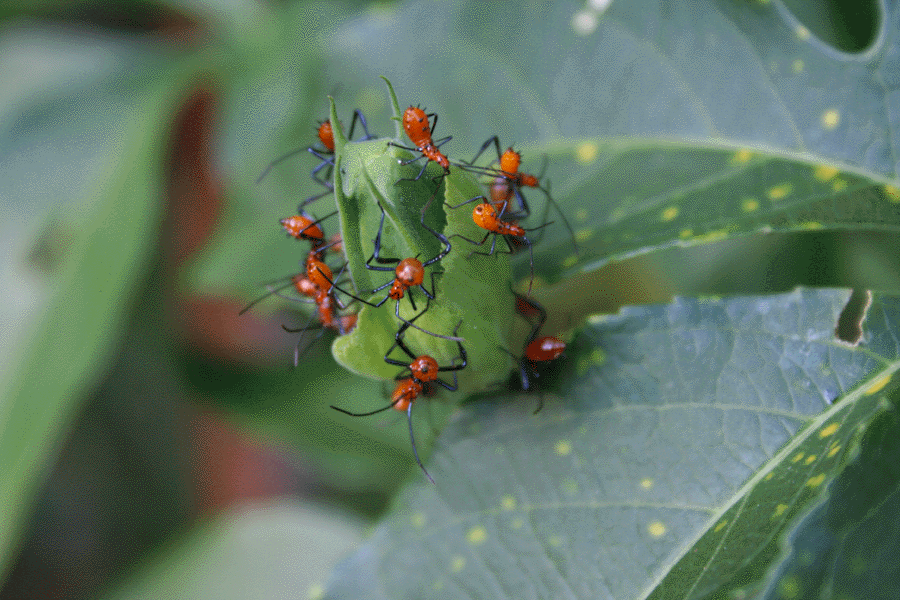
The presence of orange bugs on tomato plants can cast a shadow on the vibrant foliage and the promise of luscious harvests. These pests, though small in size, can wreak havoc on the health and yield of tomato plants. Understanding these invaders, their behaviors, and effective strategies to manage them is crucial for nurturing thriving tomato gardens. Let’s explore the world of orange bugs on tomato plants and uncover methods to safeguard these beloved garden denizens.
Table of Contents
What Is The Orange Ant Like Bug On My Tomato Plant?
The orange ant-like bug on your tomato plant is likely to be a type of aphid. Aphids are small insects that come in various colors, including orange, and they often resemble ants. These pests feed on plant sap by piercing the plant tissue with their mouthparts.
Identifying the Culprits:
- Common Types: Common orange bugs found on tomato plants include aphids, stink bugs, and certain types of beetle larvae, all exhibiting distinct physical characteristics.
- Physical Traits: Orange bugs vary in size and shape but often share a vibrant orange hue, with some displaying distinct markings or patterns.
- Behavioral Patterns: They tend to cluster on the undersides of leaves, feeding on plant sap, which can lead to wilting, stunted growth, and reduced fruit production.
The Impact of Orange Bugs on Tomato Plants
Understanding the impact of orange bugs on tomato plants is pivotal in preserving the health and productivity of these cherished garden inhabitants. The repercussions of these pests extend beyond their vibrant appearance, often leading to tangible and detrimental effects on tomato plants.
1. Damage to Foliage and Growth
Orange bugs, such as aphids, stink bugs, or certain beetle larvae, have a penchant for feasting on the sap of tomato plants. Their piercing mouthparts puncture the plant tissue, causing damage that manifests in various ways:
- Leaf Yellowing: Continuous sap extraction can result in yellowing or discoloration of leaves, affecting their ability to photosynthesize effectively.
- Stunted Growth: The nutrient loss from excessive feeding can stunt the growth of stems and foliage, hindering the plant’s overall development.
2. Transmission of Diseases
- Virus Transmission: Some orange bugs carry and transmit viruses that can infect tomato plants, leading to diseases that impair growth and reduce yield.
Beyond physical damage, orange bugs can also act as vectors for plant diseases, indirectly harming tomato plants:
3. Impact on Yield and Quality
The cumulative effect of sustained infestations can significantly impact the productivity and quality of tomato plants:
- Reduced Fruit Production: Severely affected plants may yield fewer fruits, affecting the overall harvest.
- Compromised Quality: Pests’ feeding activities can deform or damage the fruits, reducing their aesthetic appeal and market value.
4. Weakening Plant Resilience
Continuous stress caused by orange bug infestations weakens the plant’s resilience and ability to combat other environmental stresses:
- Vulnerability to Secondary Pests: Weakened plants become more susceptible to other pests or diseases, further compromising their health.
How Do I Get Rid 0f Orange Bugs On My Tomato Plants?
Getting rid of orange bugs on your tomato plants requires a multifaceted approach that aims to reduce their population while preserving the health of the plants. Here are comprehensive steps to effectively manage and eliminate these pests:
1. Identification and Confirmation
Begin by confirming the specific type of orange bug infesting your tomato plants. Identifying whether they are aphids, stink bugs, or beetle larvae helps in choosing the most suitable control methods.
2. Cultural Practices for Prevention
- Regular Inspection: Conduct routine checks of your tomato plants, particularly the undersides of leaves where these bugs often gather.
- Weeding and Pruning: Remove weeds and trim excess foliage to minimize hiding spots and breeding grounds for pests.
- Sanitation: Keep the garden area clean by removing debris and fallen leaves that can harbor bugs.
3. Natural Predators and Biological Controls
- Beneficial Insects: Encourage the presence of natural predators like ladybugs, lacewings, or parasitic wasps that feed on orange bugs.
- Attracting Birds: Birds are natural predators of pests. Bird feeders or birdbaths can attract birds to your garden, aiding in bug control.
4. Mechanical Removal
Handpicking: For smaller infestations, manually remove the bugs by hand and dispose of them in soapy water to prevent their return.
5. Eco-Friendly Solutions
- Neem Oil: Neem oil acts as an effective insecticide that disrupts the reproductive cycle of pests like aphids and stink bugs.
- Insecticidal Soaps: These soaps suffocate soft-bodied pests like aphids while being safe for plants and beneficial insects.
6. Chemical Controls (as a Last Resort)
Selective Insecticides: Consider using targeted insecticides if natural and eco-friendly methods fail. Use insecticides labeled for vegetable plants and follow application instructions carefully to minimize harm to beneficial insects and the environment.
Conclusion
Navigating the presence of orange bugs on tomato plants demands vigilance, understanding, and a multifaceted approach. By identifying these pests, recognizing their impact, and implementing preventive measures such as cultural practices, natural predators, and cautious use of controls, gardeners can safeguard their tomato plants from the detrimental effects of these orange-hued invaders. Preserving the health and vitality of tomato plants not only ensures a bountiful harvest but also maintains the beauty and resilience of these garden treasures.
